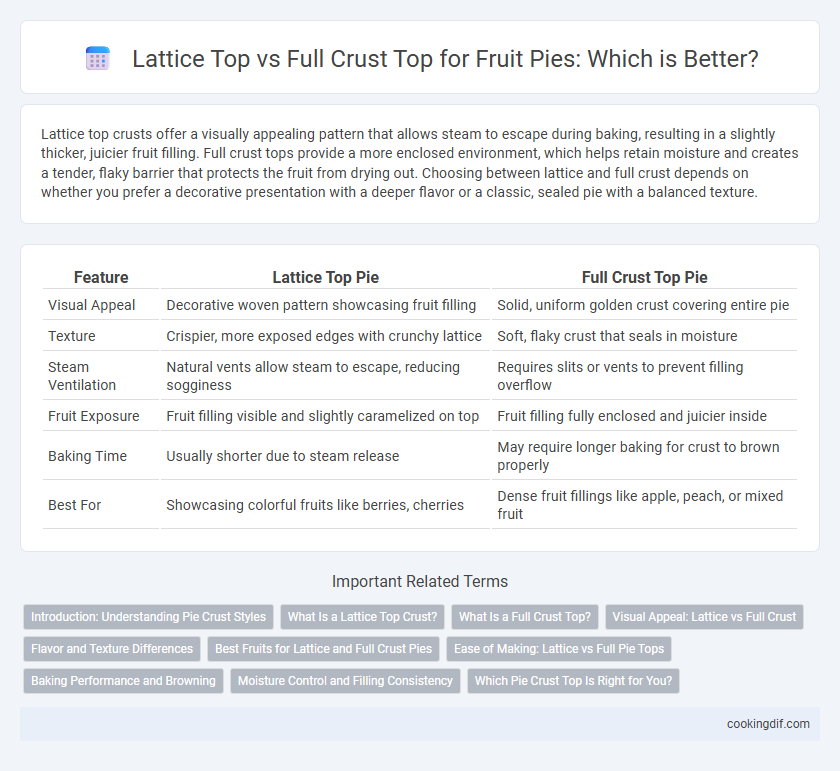Lattice top crusts offer a visually appealing pattern that allows steam to escape during baking, resulting in a slightly thicker, juicier fruit filling. Full crust tops provide a more enclosed environment, which helps retain moisture and creates a tender, flaky barrier that protects the fruit from drying out. Choosing between lattice and full crust depends on whether you prefer a decorative presentation with a deeper flavor or a classic, sealed pie with a balanced texture.
Table of Comparison
| Feature | Lattice Top Pie | Full Crust Top Pie |
|---|---|---|
| Visual Appeal | Decorative woven pattern showcasing fruit filling | Solid, uniform golden crust covering entire pie |
| Texture | Crispier, more exposed edges with crunchy lattice | Soft, flaky crust that seals in moisture |
| Steam Ventilation | Natural vents allow steam to escape, reducing sogginess | Requires slits or vents to prevent filling overflow |
| Fruit Exposure | Fruit filling visible and slightly caramelized on top | Fruit filling fully enclosed and juicier inside |
| Baking Time | Usually shorter due to steam release | May require longer baking for crust to brown properly |
| Best For | Showcasing colorful fruits like berries, cherries | Dense fruit fillings like apple, peach, or mixed fruit |
Introduction: Understanding Pie Crust Styles
Lattice top and full crust top are two popular pie crust styles, each offering distinct textures and visual appeal. A lattice top consists of interwoven strips of dough that allow steam to escape and showcase the fruit filling, enhancing juiciness and flavor concentration. In contrast, a full crust top provides a sealed enclosure that locks moisture in, resulting in a tender, flaky crust while maintaining the pie's structural integrity.
What Is a Lattice Top Crust?
A lattice top crust features interwoven strips of dough arranged in a crisscross pattern, allowing steam to escape and showcasing the fruit filling. This design not only enhances the pie's visual appeal but also results in a lighter, less doughy texture compared to a full crust top. Lattice tops are especially popular for fruit pies like apple, cherry, and berry varieties, balancing structure and ventilation.
What Is a Full Crust Top?
A full crust top on a fruit pie is a single sheet of dough that completely covers the filling, sealing in juices and creating a golden, flaky exterior. This traditional style helps retain moisture and allows steam to escape through vent cuts, preventing sogginess while enhancing texture. Full crust tops contrast with lattice tops by providing a uniform barrier that protects the fruit filling during baking, resulting in a classic, rich pie experience.
Visual Appeal: Lattice vs Full Crust
Lattice tops showcase the vibrant filling through a crisscross pattern, creating an inviting and rustic visual appeal ideal for fruit pies. Full crust tops offer a smooth, uniform surface that can be decorated with intricate cutouts or patterns, delivering a polished and classic appearance. The choice between lattice and full crust affects both presentation style and the ability to highlight the pie's colorful fruit filling.
Flavor and Texture Differences
Lattice top pies allow steam to escape during baking, resulting in a fruit filling that is thick and slightly concentrated, with a balanced sweetness and tartness that enhances the pie's overall flavor. The open crust creates a crisp, flaky texture on top, offering a contrast to the soft, juicy filling beneath. Full crust tops trap steam, producing a moister, more tender crust but sometimes a softer filling with less pronounced fruit flavors due to limited evaporation.
Best Fruits for Lattice and Full Crust Pies
Lattice tops are ideal for fruits with high moisture content like berries, cherries, and peaches, as the open design allows steam to escape, preventing sogginess and enhancing caramelization. Full crust tops work best for firmer fruits such as apples, pears, and quinces, providing a protective barrier that locks in juices and creates a tender, flaky pastry. Both crust styles benefit from fruits with balanced sweetness and acidity to achieve the perfect pie texture and flavor.
Ease of Making: Lattice vs Full Pie Tops
Lattice tops require more precision and time to weave strips of dough evenly, making them moderately challenging for beginners compared to full crust tops, which involve rolling out a single sheet of dough to cover the pie. Full crust tops are simpler and quicker to make, as they require fewer steps and less attention to detail during assembly. Bakers seeking a decorative yet somewhat easy approach often prefer lattice tops, while those prioritizing speed and simplicity opt for full crust tops.
Baking Performance and Browning
Lattice top pie crusts promote even heat circulation, resulting in a more uniform baking performance and enhanced browning on exposed fruit edges. Full crust tops provide better moisture retention, yielding a softer crust but potentially less pronounced browning due to limited direct heat exposure. Each crust style affects caramelization differently, influencing both texture and color of the final fruit pie.
Moisture Control and Filling Consistency
Lattice top pie crusts allow steam to escape during baking, which helps control moisture levels and prevents a soggy filling by promoting evaporation. Full crust tops trap steam inside, often resulting in a juicier filling but can lead to excess moisture that makes the crust soggy if not vented properly. Choosing lattice over full crust is ideal for maintaining a consistent, well-balanced filling texture by regulating moisture release.
Which Pie Crust Top Is Right for You?
Lattice top pie crusts offer a visually appealing, ventilated design that allows steam to escape, keeping fruit fillings like cherry or blueberry bubbly and preventing sogginess. Full crust tops provide a sealed, evenly baked surface ideal for thicker fillings such as apple or peach, retaining moisture and enhancing flavor concentration. Choosing between lattice and full crust depends on desired texture, presentation, and the type of fruit filling used.
Lattice top vs full crust top for fruit pies Infographic

 cookingdif.com
cookingdif.com